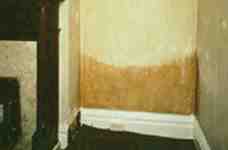 |

Rising Damp is the action of water moving vertically through porous building material in contact with ground.This is brought about by the drying action of air on upper surfaces, which causes the wall to act like a wick. Water will move up the wall by capillary action and evaporate from the surface into the atmosphere. The height to which the dampness may rise varies accordingly to construction but rarely exceeds 1.2 metres above ground level. Water coming from the soil will have dissolved various nitrate, chloride and other salts (called ground salts) and will carry these salts up into the brickwork and plaster.As the water evaporates an ever increasing amount of these salts will be deposited in the wall. As these ground salts are easily dissolved they also readily attract moisture from the atmosphere (Hygroscopic Salts). This means that even if the rising damp is cured the plaster will always be damp. For this reason the plaster is always removed when treating rising damp. Rising damp suffered
by properties with a timber ground floor may also suffer from problems
associated with wood rot. A sub floor inspection is strongly recommended.
PENETRATING DAMP Penetrating damp in a wall is usually from a source such as wind driven rain, poor guttering and leaking overflow pipes, causing moisture to enter the structure in a horizontal direction. Gravity may cause the downward movement of the resultant dampness. Defective brickwork, cracked render, faulty pointing, poor flashings, poor guttering and downpipes can also add to the problem. Penetrating damp can create isolated patches of dampness that increase in size after periods of heavy rain and tend to disappear in long dry spells of weather. Laterally penetrating damp is a term applied to moisture, which travels horizontally from a source bridging the installed damp course such as high external ground level or earth retaining walls below ground level. CONDENSATION Condensation is a common problem in most properties. Water vapour contained in the warm atmosphere (the humidity) is sealed into the structure as a result of double glazing, draft-proofing or the sealing up of a disused chimney. When the temperature drops this vapour condenses on colder surfaces such as windows and external walls resulting in damp areas. These are usually in poorly ventilated spaces i.e. corners of rooms, bedroom cupboards and behind furniture. PREVENTION The following are terms, which commonly require attention on older buildings to prevent remedial works being necessary.
Classic damp Ask for a free survey
and quotation by either phoning or E-mailing
me. Tel: 01915810705 [Damp
Proofing][WallTies][Woodworm][Wet
& Dry Rot][Plastering][Basement
Tanking]
|
